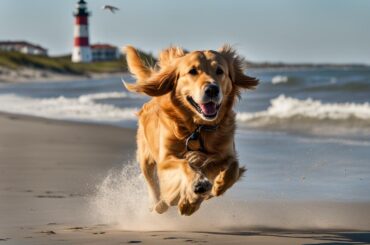When it comes to traveling with your furry friend, proper planning and preparation are key to ensuring a safe and stress-free journey. Whether you’re flying with dogs or embarking on a road trip, there are important considerations to keep in mind. In this comprehensive guide, I will provide you with essential tips and expert advice to make your flight day with your dog a breeze.
Key Takeaways:
- Choose pet-friendly airlines
- Prepare your dog for the flight
- Familiarize yourself with airline regulations
- Ensure comfortable travel for your dog
- Understand in-cabin pet policies
Health and Safety for Dog Travel
When it comes to traveling with your dog, ensuring their health and safety is of utmost importance. By taking the necessary precautions, you can ensure a smooth and stress-free journey for both you and your canine companion.
One of the first steps in preparing for dog travel is scheduling a visit to the veterinarian. A health checkup will help identify any underlying issues or conditions that may affect your dog’s comfort during the trip. Additionally, make sure all vaccinations are up-to-date to protect your dog from common diseases.
Discuss any necessary medications with your vet. This may include items such as motion sickness medication or anxiety-relieving supplements. I recommend that you have these on hand in case your dog experiences any discomfort during travel.
In case of emergencies, I would advise that you be prepared. Research and locate the nearest 24-hour veterinary hospital to your travel destination. Keep their contact information handy in case you need immediate assistance for your dog. Try to program their contact information into your phone for easy access.
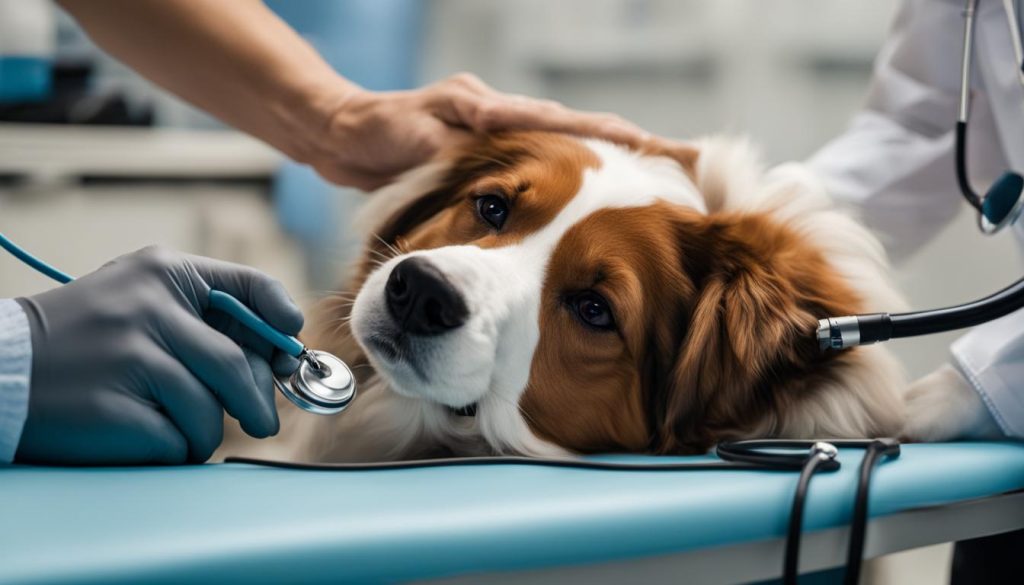
Emergency Veterinary Hospital Contact Information
| Emergency Vet Hospital | Address | Phone Number |
|---|---|---|
| Ace Animal Hospital | 123 Main Street | (555) 123-4567 |
| Paws Emergency Clinic | 987 Elm Avenue | (555) 987-6543 |
| Animal Care Specialists | 456 Oak Road | (555) 456-7890 |
In addition to seeking veterinary care, prioritize your dog’s physical and mental fitness for travel. Engage in regular exercise before the trip to ensure your dog is in good shape. Mental stimulation through training and puzzle toys can also help keep your dog engaged during the journey.
By taking these health and safety measures, you can ensure a comfortable and secure travel experience for your furry friend.
Dog Travel Crates
When it comes to traveling with your dog, a reliable and comfortable crate is essential. Not only does it provide a secure space for your pet, but it also ensures their safety during the journey. Here are some key considerations when choosing a dog travel crate:
Proper Crate Size
I highly suggest that you select a crate that is appropriate for your dog’s size. The crate should be spacious enough for your dog to stand, turn around, and lie down comfortably. However, it shouldn’t be too large, as this can result in a lack of stability during transportation. Measure your dog’s height, length, and width accurately to determine the right crate size.
Ventilation and Labeling Requirements
A well-ventilated crate is essential to ensure your dog’s comfort and well-being during the journey. Look for crates with ample ventilation holes or mesh panels to allow proper airflow. Additionally, it’s necessary to label the crate with your contact information, including your name and phone number. This helps to identify your pet in case of any mishaps or emergencies.
Orthopedic Dog Crate Pad and Dog Water Bottle
Make your dog’s crate cozy and comfortable by adding an orthopedic crate pad. This provides cushioning for your dog’s joints and enhances their overall comfort. Additionally, don’t forget to include a water bottle inside the crate, ensuring that your dog stays hydrated throughout the trip.

Investing in an airline-approved dog crate that meets proper ventilation and labeling requirements, along with providing essential items like an orthopedic dog crate pad and a water bottle, will ensure a safe and comfortable travel experience for your furry friend.
Dog Identification
Proper identification is crucial when traveling with your dog to ensure their safety and well-being. Here are some essential identification items you should have:
Dog Collar
A sturdy dog collar is a must-have for your furry friend. Make sure the collar is comfortable and properly fitted. It should have a metal or plastic buckle for easy fastening and a D-ring for attaching identification tags.
Identification Tags
Attach identification tags to your dog’s collar with up-to-date contact information. Include your dog’s name, your name, and your home phone number. In case your dog gets lost, these tags will help others identify your dog and contact you.
Proof of Rabies Vaccination
When traveling with your dog, carry proof of their rabies vaccination. Some airlines and accommodations may require this documentation. Make sure the vaccination is up-to-date and keep a copy of the certificate with your travel documents.
Microchip
A microchip is a safe and permanent way to identify your dog. It’s a small device inserted under the skin, which can be scanned by veterinarians, shelters, and animal control officers. Register your dog’s microchip with your contact information to help reunite you if your dog gets lost.
Recent Picture
Carry a recent picture of your dog with you while traveling. This will be useful if you need to create missing posters or provide a clear description to others in the event your dog goes missing.
Health Records
Bring your dog’s health records, including vaccination history and any necessary medications. These records may be required by airlines, hotels, or other accommodations. I recommend that you have all the necessary documentation to ensure a smooth and hassle-free trip.
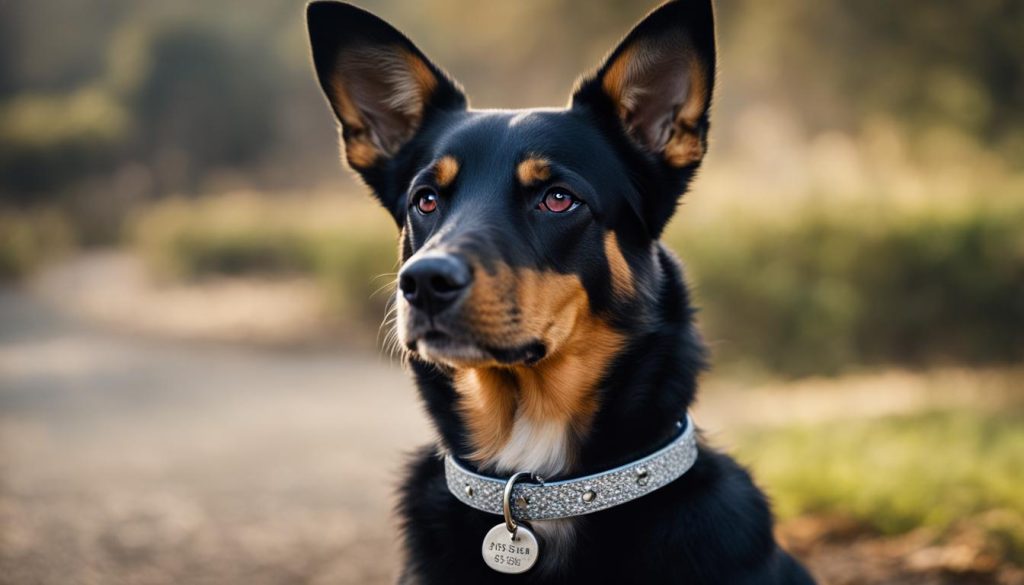
Traveling By Car With Your Dog
When it comes to traveling with your dog, taking a road trip can offer flexibility and convenience. However, ensure the safety and comfort of your furry friend during the journey. Here are some essential tips for car travel with dogs:
- Car Sickness Prevention: Just like humans, dogs can experience car sickness. To prevent this, let your dog travel on an empty stomach but ensure they have access to water. Avoid feeding them right before the journey and consider using car sickness medications recommended by your veterinarian.
- Well-Ventilated Car: Dogs may get hot or uncomfortable during the trip, especially on long drives. Ensure that the car is well-ventilated by opening windows slightly or using a fan. Never leave your dog alone in a closed vehicle as it can lead to heatstroke.
- Dog Seat Belt or Car Seat: To keep your dog safe and secure during car travel, consider using a dog seat belt or a car seat specifically designed for dogs. These devices provide a level of protection and prevent your dog from roaming around the car, which can be distracting to the driver.
- Safety Precautions: Always prioritize safety when traveling with your dog. Secure loose objects in the car that can potentially harm your pet during sudden stops or turns. Avoid letting your dog hang their head out of the window, as this can be dangerous and increase the risk of injury.
- Frequent Breaks: Dogs need regular exercise and bathroom breaks, especially during long drives. Plan frequent stops along the way to give your dog an opportunity to stretch their legs, relieve themselves, and stay comfortable throughout the journey.
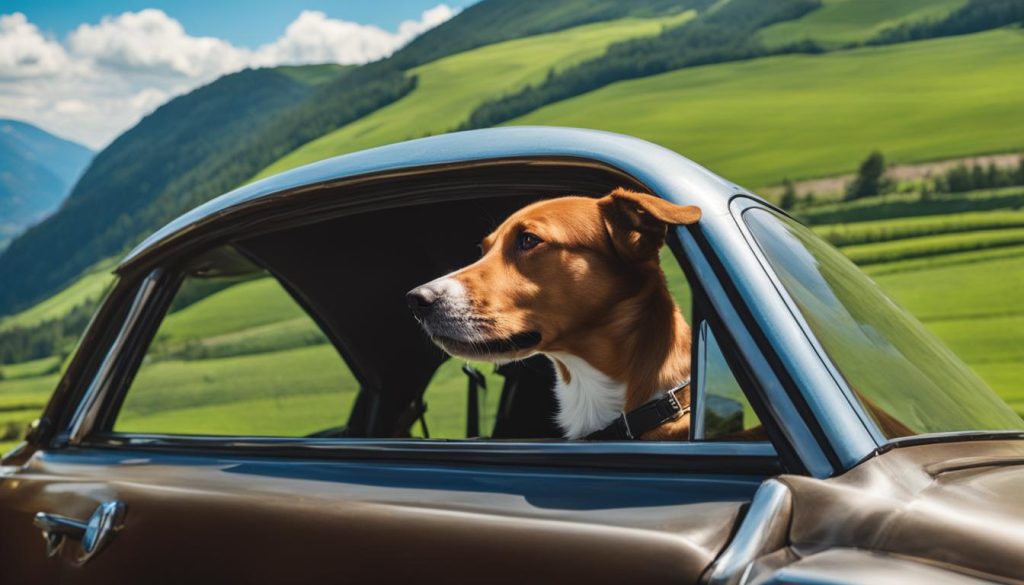
By following these tips, you can ensure a safe and enjoyable road trip with your furry companion. Try to pack essentials such as food, water, treats, toys, and a leash. Additionally, consider bringing a comfortable bed or blanket for your dog to relax during breaks. With proper preparation and attention to your dog’s needs, car travel can be a fantastic bonding experience for both you and your canine companion.
Flying With Dogs
When it comes to flying with dogs, there are several important considerations to keep in mind to ensure a smooth and stress-free journey for both you and your furry friend. Before you embark on your trip, please schedule a visit to your veterinarian for a thorough health check and certification of your dog’s overall well-being. This step is particularly important as many airlines require documentation from a veterinarian stating that your dog is fit to fly.
Once your dog has been cleared for travel, I would advise that you familiarize yourself with the specific regulations set by the airline you will be flying with. Each airline has its own policies regarding crate requirements, in-cabin pet policies, and temperature considerations. I highly suggest that you adhere to these regulations to ensure the comfort and safety of your dog throughout the journey.
In terms of crate requirements, it is essential to choose an airline-approved crate that meets the size and labeling requirements. This crate will serve as your dog’s safe and secure space during the flight. Additionally, pack essentials such as a comfortable crate pad, water bowl, and any toys or blankets that will help keep your dog calm and relaxed during the journey.
By following these guidelines and ensuring that all necessary preparations have been made before your flight, you can ensure a positive and enjoyable experience when flying with your dog.

Table: Airline Regulations for Flying with Dogs
| Airline | Crate Requirements | In-Cabin Pet Policies | Temperature Considerations |
|---|---|---|---|
| Airline A | Hard-sided crate, specific dimensions, proper ventilation | Small dogs allowed in cabin with carrier under the seat | Avoid extreme temperatures, provide cooling or heating options |
| Airline B | Soft-sided crate, specific dimensions, secure zippers | Small dogs allowed in cabin with carrier under the seat | Avoid extreme temperatures, provide cooling or heating options |
| Airline C | Hard-sided crate, specific dimensions, secure latches | Dogs not allowed in cabin, must travel in cargo hold | Avoid extreme temperatures, provide cooling or heating options |
Dogs on Trains, Buses, and Boats
Traveling with your dog doesn’t have to be limited to planes and cars. Many public transportation options and cruises offer pet-friendly policies, allowing you to include your furry friend in your travel adventures. However, be aware of any size restrictions and local policies that may apply.
Train and Bus Travel with Dogs
When considering train or bus travel with your dog, I would advise that you check with the respective companies beforehand. Some companies may have size restrictions, requiring smaller dogs to be transported in carriers. It’s also important to inquire about any specific policies or additional fees that may apply. By doing your research and planning ahead, you can ensure a smooth journey for both you and your canine companion.
Pet-Friendly Cruises
If you’re considering a cruise for your vacation, there are pet-friendly options available. However, please check the specific policies of the cruise line or ship. Some cruises may have restrictions on the number or size of dogs allowed onboard. Additionally, there may be designated areas or restrictions regarding where your dog can accompany you on the ship. By understanding and adhering to these policies, you can enjoy a memorable cruise vacation with your furry friend.
International Travel with Pets
For those planning international travel with their pets, research the required documentation and regulations for pet travel to your destination. Each country may have different requirements, including health certificates, vaccinations, and quarantine periods. Consulting with your veterinarian and contacting the embassy or consulate of your destination country will provide you with the necessary information to ensure a smooth and safe journey for your dog.

Table: Pet-Friendly Travel Options
| Transportation Type | Policies | Restrictions |
|---|---|---|
| Trains | Check with respective companies | Size restrictions, carrier requirements |
| Buses | Check with respective companies | Size restrictions, carrier requirements |
| Cruises | Check specific cruise line policies | Number and size restrictions, designated areas |
| International Travel | Research required documentation and regulations | Health certificates, vaccinations, quarantine periods |
Dog-Friendly Vacations
When planning a vacation with your dog, consider their needs and ensure that your accommodations are dog-friendly. Dog-friendly hotels and lodging options provide a comfortable and welcoming environment for both you and your furry companion. However, I would advise that you be mindful of the lodging policies, pet etiquette, and vacation home safety to ensure a pleasant experience for everyone involved.
Lodging Policies and Pet Etiquette
Before booking your stay, research the pet policies of the hotel or vacation rental. Some places may have size restrictions, breed limitations, or additional fees for pets. I highly suggest that you adhere to these policies to avoid any issues during your stay. Additionally, be considerate of other guests and follow proper pet etiquette. Keep your dog on a leash in common areas, clean up after them, and avoid leaving them unattended in the room.
Vacation Home Safety
When staying in a vacation home, I would advise that you ensure the safety of your dog. Puppy-proof the space by removing any potentially hazardous items or substances. Secure windows and doors to prevent any escapes, and make sure the yard or outdoor area is secure as well. Familiarize yourself with the neighborhood to find designated walking areas and parks where you can take your dog for exercise and bathroom breaks.
Managing Stress and Anxiety
Traveling can be stressful for dogs, so manage their stress and anxiety during your vacation. Maintain a calm and relaxed demeanor, as dogs often mirror their owner’s emotions. Bring familiar items from home, such as their bed or a favorite toy, to provide comfort and a sense of familiarity. Stick to their regular feeding and exercise routine as much as possible to provide stability and reduce anxiety.

| Travel Tip | Explanation |
|---|---|
| Research dog-friendly hotels | Ensure that your destination offers dog-friendly accommodations. |
| Respect lodging policies | Adhere to the pet policies and rules set by the hotel or rental. |
| Clean up after your dog | Be responsible and maintain cleanliness in common areas. |
| Manage your dog’s stress | Provide familiar items and stick to their regular routine. |
Planning for Your Dog’s Needs
When traveling with your dog, plan for their needs throughout the journey. From bathroom breaks to providing entertainment and ensuring their food and water requirements are met, here are some essential considerations to keep in mind.
Bathroom Breaks
Just like humans, dogs need regular bathroom breaks, especially during long trips. Plan for frequent stops where your dog can relieve themselves in safe and appropriate areas. It’s helpful to train your dog to go on multiple surfaces, such as grass, gravel, or pavement, to make it easier for them to find suitable spots during travel.
Games and Toys
Keeping your dog entertained during the trip is essential to prevent boredom and anxiety. Pack their favorite toys and interactive games to engage them during downtime. Puzzle toys and treat-dispensing toys can be especially effective in keeping them mentally stimulated. However, ensure that the toys are safe and won’t pose a choking hazard during travel.
Food and Water
I recommend that you maintain your dog’s regular feeding schedule and provide them with access to fresh water throughout the trip. Pack their regular food in a secure container and bring along collapsible bowls for easy storage and feeding. Try to offer small, frequent meals rather than large ones to avoid stomach upset, especially during car or air travel.
Collapse Bowl

| Advantages | Disadvantages |
|---|---|
| Easy to carry and store | May not be suitable for large dogs |
| Lightweight and portable | May not withstand heavy use |
| Durable and waterproof | May not be dishwasher safe |
By planning for your dog’s needs during travel, you can ensure a comfortable and enjoyable experience for both you and your furry companion. Try to schedule bathroom breaks, provide stimulating toys and games, and pack their regular food and collapsible bowls for convenience. With proper planning, your dog will be well-equipped for a smooth journey.
Dog Travel Accessories
When it comes to traveling with your dog, having the right accessories can make all the difference in ensuring a comfortable and stress-free journey. Here are some essential dog travel accessories that you should consider:
Car Seat Covers
Investing in car seat covers is a great way to protect your vehicle from fur, dirt, and other messes that your dog may bring along on your travels. These covers are designed to fit over your car seats, providing a barrier that keeps them clean and free from damage. They are usually made from durable, waterproof materials that are easy to clean, making them a practical choice for any dog owner.
Seat Belts or Harnesses for Dogs
Ensuring your dog’s safety during car travel is essential. Using a seat belt or harness specifically designed for dogs can help keep them secure, preventing them from moving around or becoming a distraction while you’re driving. These restraints are typically adjustable and attach to your car’s seat belt system or seat anchors, providing a safe and comfortable traveling experience for your furry friend.
Travel Bowls
Keeping your dog hydrated and well-fed during your journey is crucial. Travel bowls are convenient and portable, allowing you to provide food and water for your dog wherever you go. Look for collapsible bowls that are lightweight and easy to pack, so you can have them readily available whenever your dog needs a snack or a drink.
Calming Products
Traveling can be stressful for some dogs, especially if they are prone to anxiety or motion sickness. Calming products, such as natural supplements or pheromone sprays, can help alleviate their stress and promote a sense of calmness. Consult with your veterinarian to find the right calming product for your dog’s needs and try them out before your journey to ensure their effectiveness.
Travel Crates or Carriers
If you’re traveling by air or need a safe and cozy space for your dog during the journey, a travel crate or carrier is a must-have accessory. Make sure to choose a crate or carrier that meets airline requirements if you’re flying, or select one that is spacious, well-ventilated, and secure for car travel. Your dog should have enough room to stand, turn, and lie down comfortably, providing them with a sense of security throughout the trip.
By equipping yourself with these essential dog travel accessories, you’ll be well-prepared to ensure a comfortable and enjoyable journey for both you and your canine companion. To put it simply, the key to successful dog travel is planning and preparation, so make sure to pack these items along with other essentials for a stress-free adventure.
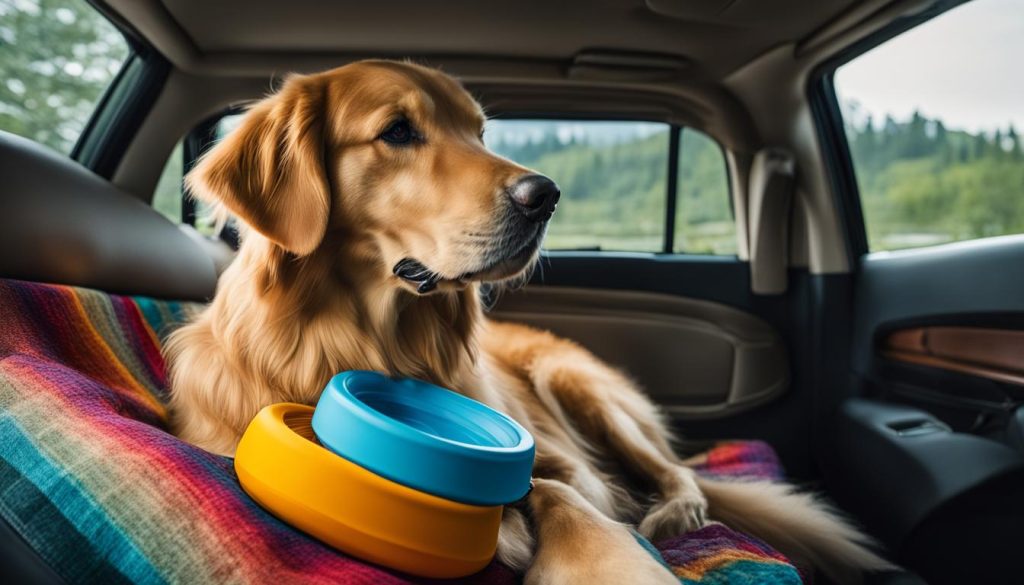
Dog-Friendly Hotels and Lodging
When traveling with your dog, finding pet-friendly accommodations is essential. Many hotels and lodging establishments now offer pet policies that cater to the needs of dog owners. However, be mindful of the rules and regulations in place to ensure a pleasant stay for everyone. Here are some key considerations to keep in mind:
Pet Policies
Before booking a hotel or lodging, thoroughly review their pet policies. Different establishments may have varying rules regarding dog size, breed restrictions, and additional fees. Ensure that the hotel you choose is truly dog-friendly and provides the amenities and facilities necessary for your pet’s comfort. Some hotels may also have designated dog-friendly areas or offer special perks such as dog beds or bowls.
Keeping Your Dog Quiet
One common concern when staying in a hotel with your dog is keeping them quiet to avoid disturbing other guests. Be mindful of your dog’s behavior and invest time in proper training beforehand. Consider bringing your dog’s favorite toys or treats to keep them occupied and help prevent excessive barking or noise. If your dog tends to be anxious or vocal, it may be helpful to bring calming products or consult with a veterinarian for advice on creating a calm environment.
Not Leaving Your Dog Unattended
I recommend that you never leave your dog unattended in a hotel room. Dogs can become stressed or anxious when left alone in unfamiliar surroundings, potentially leading to disruptive behavior or accidents. If you need to leave the room, make arrangements to bring your dog with you or find a local dog daycare or pet-sitting service to ensure their well-being. Some hotels may have specific guidelines regarding this, so be sure to comply with their policies.
Designated Walking Areas
When staying at a pet-friendly hotel, inquire about designated walking areas for dogs. Many hotels have designated outdoor spaces or nearby parks where you can take your dog for walks and bathroom breaks. Familiarize yourself with the hotel’s rules regarding dog walking to ensure you are using the correct areas and cleaning up after your pet. Be a responsible dog owner and help keep the hotel premises clean and enjoyable for everyone.
Cleaning Up After Your Dog
Always be prepared to clean up after your dog while staying at a pet-friendly hotel. Carry waste bags with you whenever you take your dog outside. Properly dispose of waste in designated receptacles and follow any additional guidelines provided by the hotel. This not only helps maintain a clean and hygienic environment but also demonstrates responsible pet ownership.
By being considerate of the pet policies, keeping your dog quiet, never leaving them unattended, utilizing designated walking areas, and cleaning up after them, you can ensure a positive experience when staying at dog-friendly hotels and lodging establishments. Try to always follow the rules and be respectful of other guests to maintain a welcoming and pet-friendly atmosphere.

Final Thoughts
After considering all the essential tips for traveling with your dog, it is clear that with proper planning and preparation, you can ensure safe and enjoyable travel experiences for both you and your furry companion. By prioritizing your dog’s health and well-being, choosing the right travel accessories, and following airline and hotel policies, you can create a stress-free journey.
Try to schedule a visit to the veterinarian for a health checkup and ensure that all vaccinations are up-to-date. Choose an airline-approved dog crate that provides comfort and security for your pet during the flight. Proper identification, such as a collar with identification tags and a microchip, is essential in case your dog gets lost.
During car travel, take necessary precautions like preventing car sickness and making frequent stops for exercise and bathroom breaks. When staying at a dog-friendly hotel or lodging, adhere to their pet policies and be considerate of other guests and staff. Finally, plan for your dog’s needs by bringing their regular food and water, collapsible bowls, and engaging toys to keep them entertained.
By following these key tips, you can ensure safe and enjoyable travel with your dog. Try to prioritize their comfort and well-being throughout the trip, and enjoy the adventures you’ll share together. Happy travels!
FAQ
What should I do before traveling with my dog?
Before traveling with your dog, schedule a visit to the veterinarian for a health checkup and ensure that all vaccinations are up-to-date. Discuss any necessary medications with your vet and bring a supply of your dog’s regular food and bottled water for the journey.
How can I ensure my dog’s safety during the trip?
Proper identification is crucial in case your dog gets lost during the trip. Make sure your dog has a sturdy collar with identification tags that include their name, your name, and your home phone number. Consider getting a microchip for permanent identification. Additionally, carry a recent picture of your dog and their health records listing all vaccinations.
How should I prepare for car travel with my dog?
If traveling by car, help your dog get used to the vehicle by taking short practice drives before the trip. Prevent car sickness by letting your dog travel on an empty stomach but ensure they have access to water. Keep the car well-ventilated, either with open windows or a crate with proper airflow. Consider using a dog seat belt or car seat for added safety. Make frequent stops for exercise and bathroom breaks, and never leave your dog unattended in a closed vehicle.
What should I consider when flying with my dog?
When flying with your dog, consult your veterinarian beforehand for a health check and certification. Each airline has its own regulations regarding pet travel, so familiarize yourself with their specific requirements. Consider the temperature at the departure and destination airports to ensure it’s safe for your dog. Choose an airline-approved crate that meets size and labeling requirements, or check if your dog can travel in the cabin under the seat in front of you.
What do I need to know about traveling with my dog on trains, buses, and boats?
Train and bus travel options for dogs may have size restrictions or specific policies, so check with the respective companies before planning your trip. Some cruises allow dogs on board, but I would advise that you check the specific policies of the cruise line or ship. If traveling internationally, research the required documentation and regulations for pet travel to your destination.
How can I ensure a comfortable travel experience for my dog?
Before booking accommodations, ensure that your destination offers dog-friendly hotels or lodging options. Respect the rules and policies of the establishment and be considerate of other guests and staff. Set up a safe environment in your vacation home by puppy-proofing the space and ensuring all potential hazards are removed. Don’t forget that traveling can be stressful for dogs, so manage their stress and anxiety with a calm and relaxed demeanor.
How should I plan for my dog’s needs during the trip?
Plan for your dog’s needs during the trip by training them to relieve themselves on different surfaces and bringing a supply of poop bags. Provide them with games and toys to keep them entertained and bring their regular food and bottled water to maintain their routine. Opt for collapsible bowls for easy storage and use.
What are some essential accessories for traveling with my dog?
Invest in essential accessories to ensure a comfortable and safe travel experience for your dog. Use car seat covers to protect your vehicle from fur and mess. Utilize seat belts or harnesses specifically designed for dogs to keep them secure during car travel. Bring travel bowls for food and water, and consider using calming products to ease anxiety. Choose the right travel crate or carrier that meets airline requirements and provides a cozy space for your dog.
How should I behave when staying at a dog-friendly hotel or lodging?
When staying at a dog-friendly hotel or lodging, follow the established pet policies and be respectful of other guests and staff. Keep your dog as quiet as possible and never leave them unattended. Ask the management for designated walking areas and always clean up after your dog. Maintain good behavior to ensure a positive experience and avoid causing any issues that might lead to a ban on dogs in the future.






